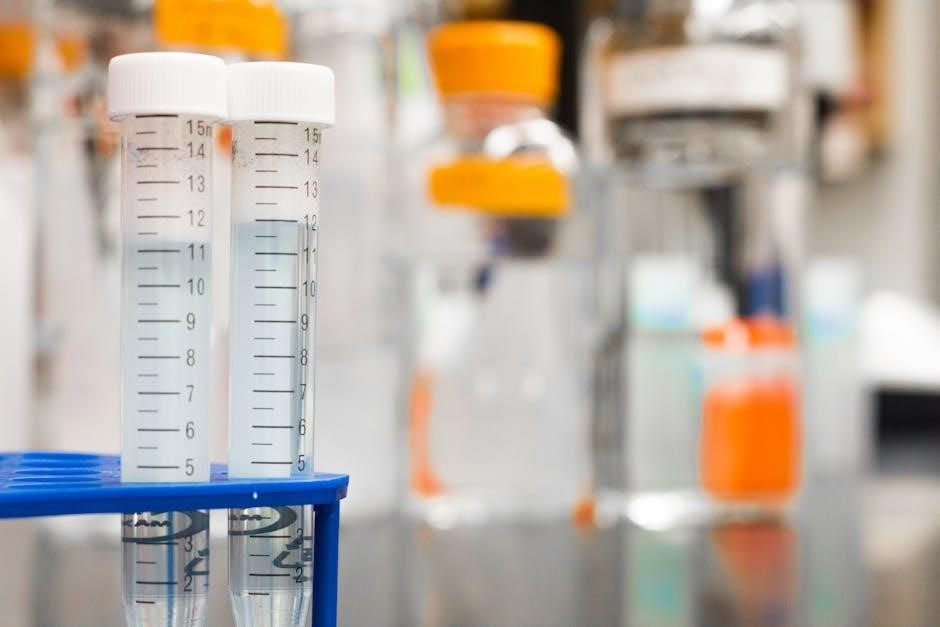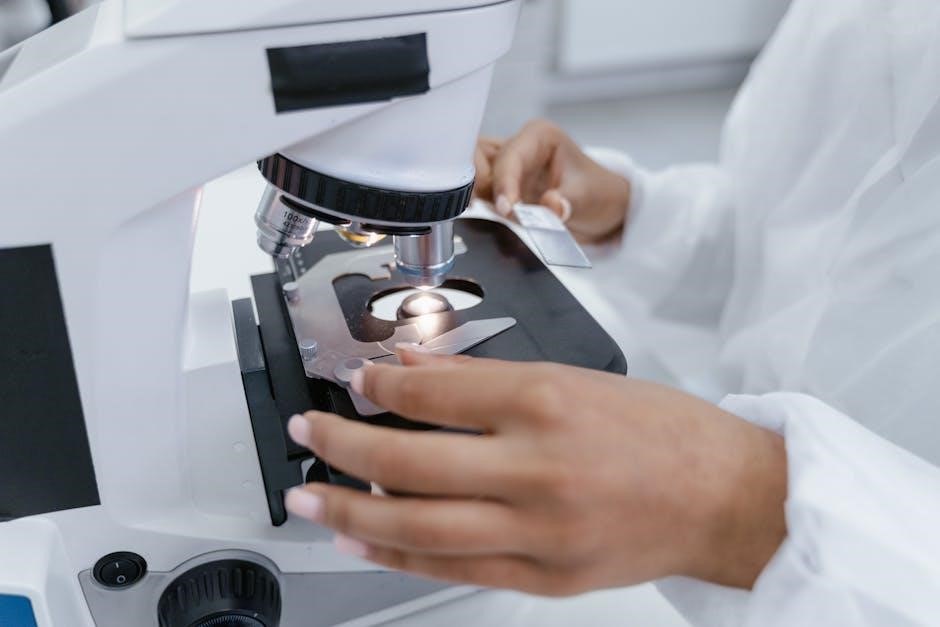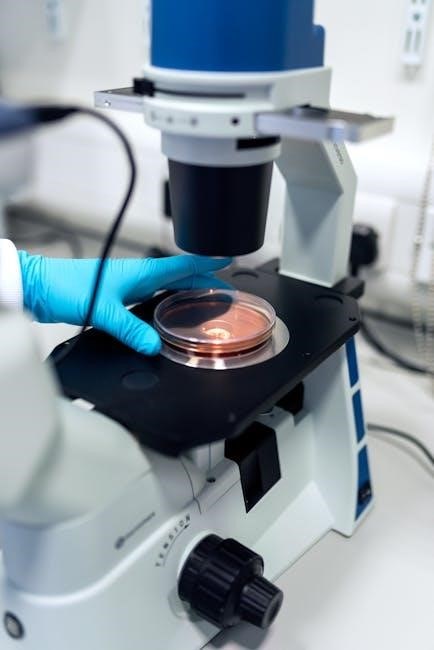
biology laboratory manual 13th edition pdf
The Biology Laboratory Manual 13th Edition by Darrell Vodopich and Randy Moore is a comprehensive guide for introductory biology courses, offering hands-on exercises and modern techniques to enhance practical skills․ Published by McGraw-Hill, this edition emphasizes experimental design, microscopy, genetics, and ecology, with integrated digital tools to support student learning and engagement․ Designed to foster scientific literacy, it provides clear instructions and over 50 exercises, making it an essential resource for understanding biological concepts and laboratory procedures․
Overview of the Manual
The Biology Laboratory Manual 13th Edition, authored by Darrell Vodopich and Randy Moore, is a comprehensive resource designed for introductory biology courses․ Published by McGraw-Hill, it provides a broad survey of fundamental laboratory techniques and experimental approaches․ The manual includes over 50 exercises, covering essential topics such as the scientific method, microscopy, cellular studies, genetics, and ecology․ It integrates traditional laboratory methods with modern digital tools to enhance student engagement and understanding․ The 13th edition emphasizes practical skills, experimental design, and data analysis, making it an invaluable tool for students to develop hands-on experience in biological investigations․ Its clear instructions and structured format ensure students can effectively navigate complex procedures and concepts․
Importance of Laboratory Manuals in Biology Education
Laboratory manuals, such as the Biology Laboratory Manual 13th Edition, play a crucial role in biology education by providing students with hands-on experience and practical skills․ These manuals bridge theoretical knowledge with experimental applications, enabling students to understand complex biological concepts through direct observation and analysis․ They also promote scientific literacy, critical thinking, and problem-solving abilities․ The structured exercises in laboratory manuals ensure consistency in learning outcomes and prepare students for advanced studies and real-world scientific challenges․ By incorporating modern techniques and digital tools, these resources enhance engagement and foster a deeper understanding of biological principles, making them indispensable in modern science education․
Key Features of the 13th Edition
The Biology Laboratory Manual 13th Edition offers enhanced features to enrich student learning․ It includes over 50 updated exercises covering essential topics such as microscopy, cell studies, genetics, and ecology․ The manual integrates digital tools, providing access to online resources for interactive simulations, data analysis, and virtual labs․ New emphasis is placed on experimental design, scientific inquiry, and safety protocols․ High-quality visuals, including diagrams and micrographs, aid in understanding complex concepts․ Additionally, the 13th edition incorporates modern techniques in molecular biology and environmental science, ensuring relevance to current scientific advancements․ These features collectively create a comprehensive and engaging learning experience, preparing students for both academic and professional challenges in biology․
Structure and Content of the Manual
The Biology Laboratory Manual 13th Edition is organized into clear sections, covering topics from the scientific method to ecology․ It includes over 50 exercises, ensuring a hands-on approach to learning biology through practical experiments and observations; Each chapter builds logically, with detailed instructions, diagrams, and safety tips, making it easy for students to follow and understand complex biological concepts․ The manual’s structure emphasizes experimentation and critical thinking, providing a comprehensive framework for introductory biology courses․
Organization of Exercises and Topics
The Biology Laboratory Manual 13th Edition is meticulously organized, with exercises and topics structured to promote progressive learning․ Each chapter begins with foundational concepts, gradually advancing to more complex biological principles․ Exercises are grouped by themes, such as the scientific method, microscopy, genetics, and ecology, ensuring a logical flow of knowledge․ Clear headings and subheadings guide students through procedures, while diagrams and data sheets enhance understanding․ The manual’s design allows students to build skills sequentially, with each exercise reinforcing previously learned material․ This systematic approach ensures that students can easily navigate the content, making it an effective tool for mastering introductory biology laboratory techniques and concepts․ The organization caters to diverse learning styles, providing a comprehensive framework for hands-on learning and scientific exploration․
Types of Laboratory Exercises Included
The Biology Laboratory Manual 13th Edition includes a diverse range of exercises designed to cover essential biological concepts and techniques․ These exercises span from introductory activities, such as exploring the scientific method and basic microscopy, to more advanced topics like genetic analysis and ecological studies․ Hands-on experiments, data collection, and analysis are central to the manual, with exercises that emphasize observation, measurement, and critical thinking․ Additionally, the manual incorporates exercises that focus on cellular biology, dissection of mammalian organ systems, and environmental investigations․ Each exercise is tailored to enhance practical skills, encouraging students to apply theoretical knowledge in real-world laboratory settings․ This variety ensures comprehensive coverage of biological principles, preparing students for both academic and professional pursuits in the life sciences․ The exercises are structured to foster curiosity and scientific literacy, making them engaging and educational for learners at all levels․
Integration of Technology and Digital Tools
The Biology Laboratory Manual 13th Edition seamlessly integrates technology and digital tools to enhance student learning and engagement․ An online companion website provides access to interactive simulations, virtual lab experiments, and multimedia resources․ Digital atlases and 3D models are included to visualize complex biological structures and processes․ Additionally, the manual incorporates data analysis software tutorials, enabling students to interpret and present experimental results effectively․ These digital tools are designed to complement traditional lab work, offering a blended learning experience․ The integration of technology not only modernizes the learning process but also prepares students for the digital advancements prevalent in scientific research and education today․ This approach ensures that students develop both practical and technological skills, fostering a dynamic and interactive learning environment․

Key Topics and Exercises Covered
A comprehensive guide covering over 50 exercises, including the scientific method, microscopy, cell studies, genetics, and ecology․ Exercises emphasize hands-on learning and the application of modern biological techniques and data analysis․
The Scientific Method and Laboratory Techniques
This section introduces students to the scientific method, emphasizing observation, hypothesis formation, experimentation, and data analysis․ It provides detailed protocols for laboratory techniques such as microscopy, DNA extraction, and dissection․ The exercises are designed to develop critical thinking and problem-solving skills, with a focus on accurate data collection and interpretation; The manual includes step-by-step instructions and safety guidelines to ensure a safe and effective learning environment․ By mastering these fundamental techniques, students build a strong foundation for advanced biological studies and real-world scientific inquiry․
Microscopy and Cell Studies
The section on microscopy and cell studies equips students with essential skills in observing and analyzing cellular structures․ Exercises guide learners through microscope setup, slide preparation, and specimen observation, emphasizing the importance of microscopy in biology․ Activities include identifying cell components, studying cell division, and exploring tissue types․ Staining techniques and digital imaging tools are introduced to enhance visualization and data collection․ This hands-on approach fosters a deeper understanding of cellular biology, preparing students for advanced studies in histology, genetics, and related fields․ By mastering microscopy, students gain proficiency in a fundamental biological technique crucial for scientific research and discovery․
Genetics and DNA Analysis
The genetics and DNA analysis section provides a detailed exploration of hereditary principles and molecular biology techniques․ Exercises include mapping genetic traits, analyzing DNA structures, and simulating DNA extraction․ Students engage with modern methods like gel electrophoresis and PCR, gaining hands-on experience in genetic experimentation․ The manual emphasizes the application of DNA technology in fields such as forensic science and biotechnology․ Clear instructions and visual aids help students grasp complex concepts, fostering a strong foundation in genetic principles and their practical applications․ These exercises prepare learners for advanced studies in genetics, biotechnology, and related scientific disciplines, bridging theory with real-world laboratory practices․
Ecology and Environmental Studies
The section on ecology and environmental studies in the Biology Laboratory Manual 13th Edition focuses on understanding interactions between organisms and their environments․ Exercises include field and laboratory investigations of population dynamics, community structure, and ecosystem functioning․ Students explore topics such as energy flow, nutrient cycling, and the impact of human activities on the environment․ Hands-on activities involve data collection, analysis, and interpretation to evaluate ecological principles and conservation strategies․ The manual emphasizes the importance of sustainability and the role of biologists in addressing environmental challenges․ These exercises provide practical insights into ecological systems, preparing students to contribute to real-world environmental solutions and fostering a deeper appreciation for biodiversity and ecosystem health․

How to Use the Manual Effectively
Maximize learning by following pre-lab instructions, conducting experiments systematically, and analyzing results thoroughly․ Utilize digital resources for enhanced understanding and organize laboratory work efficiently for optimal outcomes․
Pre-Laboratory Preparation
Pre-laboratory preparation is essential for a successful biology lab experience․ Begin by thoroughly reading the manual’s instructions and understanding the objectives of each exercise․ Familiarize yourself with required materials, safety protocols, and necessary precautions․ Review any prerequisite knowledge and skills, such as microscope operation or measurement techniques․ Organize your workspace and ensure all equipment is in working order․ Utilize the manual’s digital resources, such as pre-lab quizzes or videos, to reinforce concepts․ Plan to arrive prepared with lab reports, pencils, and a calculator․ Adhere to dress code and safety guidelines, such as wearing gloves or goggles when specified․ By being well-prepared, you can focus on learning and conducting experiments efficiently․ This foundation ensures a productive and safe laboratory environment․ ISBN-10: 1264137273, Publisher: McGraw Hill․
Conducting Experiments and Recording Data
Conducting experiments and recording data accurately are critical skills emphasized in the Biology Laboratory Manual 13th Edition․ Follow procedures carefully, ensuring precision in measurements and observations․ Use laboratory tools, such as microscopes or spectrophotometers, as instructed․ Record data systematically, labeling observations and measurements clearly․ Utilize digital tools provided in the manual for data collection and analysis․ Maintain organization by dating and titling each lab report․ Collaborate with lab partners to share responsibilities and verify findings․ Always adhere to safety protocols and clean up properly after experiments․ Accurate and thorough data collection is essential for valid conclusions and effective scientific communication․ ISBN-10: 1264137273, Publisher: McGraw Hill․
Post-Laboratory Analysis and Reporting

Supplementary Resources and Materials
The Biology Laboratory Manual 13th Edition includes supplementary resources such as an online companion website with digital tools and an instructor’s guide for enhanced teaching support․
Online Companion Websites and Digital Resources
The Biology Laboratory Manual 13th Edition is accompanied by an online companion website, offering a wealth of digital resources to enhance learning․ These include interactive simulations, virtual laboratory exercises, and multimedia tutorials that complement the manual’s exercises․ Students can access practice quizzes, video demonstrations, and downloadable data sheets to aid in their studies․ The platform also provides instructor resources, such as lecture slides and assessment tools, to support teaching․ With mobile-friendly design, students can engage with materials anytime, anywhere, making it an invaluable supplement to traditional lab work․ These digital tools foster a blended learning experience, ensuring students are well-prepared for both laboratory and theoretical aspects of biology․
Instructor’s Guide and Teaching Supplements
The 13th Edition of the Biology Laboratory Manual includes an Instructor’s Guide packed with teaching supplements to support educators․ This comprehensive resource offers detailed lesson plans, suggested demonstrations, and tips for facilitating laboratory sessions․ It includes answers to student questions, safety protocols, and alternative experiments for flexible instruction․ The guide also provides assessment tools, such as rubrics and quiz banks, to evaluate student performance․ Additionally, instructors can access PowerPoint slides, video tutorials, and other digital materials to enrich their lectures․ These supplements are designed to optimize teaching efficiency and ensure a high-quality learning experience for students, aligning with the manual’s focus on practical skills and scientific literacy․

Comparison with Previous Editions
The 13th Edition of the Biology Laboratory Manual introduces enhanced digital tools, updated exercises, and expanded content on genetics and ecology, improving upon earlier versions with modern resources and clarity․
Updates and Improvements in the 13th Edition
The 13th Edition of the Biology Laboratory Manual incorporates significant updates, including enhanced digital tools, updated exercises, and improved visual content for better student engagement․ New sections focus on modern techniques in genetics and biotechnology, while existing exercises have been refined for clarity and relevance․ The integration of online resources, such as interactive simulations and virtual labs, supports hybrid learning environments․ Additionally, the manual emphasizes emerging topics in ecology and environmental science, reflecting current scientific trends․ Pedagogical improvements include step-by-step instructions and critical thinking questions, fostering deeper understanding and practical skills․ These updates ensure the manual remains a cutting-edge resource for introductory biology students, aligning with advancements in the field and educational best practices․
Differences in Content and Structure
The 13th Edition of the Biology Laboratory Manual differs significantly from previous versions, with a reorganized structure that enhances the flow of content․ New chapters on advanced microscopy and DNA analysis have been added, while some legacy exercises have been streamlined or removed to focus on core competencies․ The manual now includes dedicated sections for digital tools and online simulations, reflecting the shift toward hybrid learning․ Additionally, the layout has been improved with clear headings, detailed diagrams, and enhanced visuals to facilitate student comprehension; These changes ensure the manual remains relevant and aligned with modern teaching methods, offering a more dynamic and interactive learning experience compared to earlier editions․

Troubleshooting Common Issues
Common issues with accessing the Biology Laboratory Manual 13th Edition PDF include download errors or accessibility problems․ Ensure a stable internet connection, use valid download links, and update your PDF reader for smooth access․ If issues persist, contact the publisher or refer to the manual’s troubleshooting guide for further assistance․
Accessing the PDF Version
Accessing the Biology Laboratory Manual 13th Edition PDF is straightforward for users with a valid subscription or purchase․ Ensure a stable internet connection and use the official McGraw-Hill website or authorized sellers like eBookMass․ Download links are often provided post-purchase, and the file size is approximately 233․6 MB․ If issues arise, verify the download link’s authenticity and update your PDF reader․ For restricted access, contact the publisher or your institution’s library․ The manual is also available through platforms like TestBankDeal, offering instant downloads․ Always check for the correct ISBN-13 (978-1264137275) to ensure authenticity․ Troubleshooting tips and guides are available online for resolving common access problems․
Understanding Complex Laboratory Procedures
The Biology Laboratory Manual 13th Edition provides detailed guidance for understanding complex laboratory procedures, ensuring students grasp fundamental techniques and advanced methods․ Exercises are designed to build practical skills, with clear step-by-step instructions and visual aids to simplify intricate processes․ Topics like microscopy, genetics, and ecology are covered with hands-on activities, allowing students to apply theoretical knowledge․ The manual emphasizes safety protocols, data collection, and analysis, preparing students for real-world scientific challenges․ Digital tools and supplementary resources further enhance comprehension, offering interactive simulations and video tutorials․ By breaking down complex procedures into manageable steps, the manual fosters confidence and proficiency in laboratory settings, making it an invaluable resource for biology education․

The Role of the Manual in Biology Education
The Biology Laboratory Manual 13th Edition serves as a cornerstone in biology education, providing structured exercises that bridge theoretical concepts with practical applications, fostering scientific literacy and critical thinking skills essential for future biologists․ Designed for introductory courses, it equips students with hands-on experience in laboratory techniques, from microscopy to genetics, while its clear instructions and integrated digital tools ensure comprehensive understanding․ By emphasizing experimental design and data analysis, the manual prepares students for advanced studies and real-world scientific challenges, making it an indispensable tool in modern biology education․ Its role extends beyond the classroom, inspiring curiosity and a deeper appreciation for biological sciences․
Enhancing Practical Skills
The Biology Laboratory Manual 13th Edition is specifically designed to enhance practical skills through hands-on exercises and real-world applications․ It provides over 50 laboratory exercises that cover essential techniques in biology, such as microscopy, cell studies, and genetic analysis․ Students gain proficiency in using laboratory equipment, conducting experiments, and interpreting data․ The manual emphasizes critical thinking and problem-solving, allowing learners to apply theoretical knowledge in practical settings․ By focusing on experimental design and procedure, it helps students master laboratory protocols and safety measures․ The inclusion of digital tools and multimedia resources further enriches the learning experience, ensuring students are well-prepared for advanced studies and future careers in science․ This focus on skill development makes the manual an invaluable resource for biology education․
Developing Scientific Literacy
The Biology Laboratory Manual 13th Edition plays a pivotal role in fostering scientific literacy by engaging students in hands-on experiments and critical thinking exercises․ It encourages learners to explore biological concepts systematically, from the scientific method to advanced techniques in genetics and ecology․ The manual’s structured approach helps students interpret data, analyze results, and draw meaningful conclusions․ By emphasizing the connection between laboratory observations and broader biological principles, it builds a strong foundation for understanding complex scientific ideas․ This edition also integrates digital tools and multimedia resources, making it easier for students to grasp challenging topics and develop a deeper appreciation for scientific inquiry and its applications in real-world scenarios․
Preparing Students for Advanced Studies
The Biology Laboratory Manual 13th Edition is designed to equip students with the skills and knowledge necessary for advanced biological studies․ By providing a comprehensive survey of laboratory techniques, it bridges the gap between foundational concepts and specialized research․ The manual’s emphasis on experimental design, data analysis, and scientific communication prepares students for the rigors of upper-level courses and professional settings․ With exercises spanning genetics, microscopy, and ecology, it fosters a well-rounded understanding of biological principles․ Additionally, the integration of digital tools and resources ensures students are proficient in modern technologies, making them confident and capable as they pursue higher education and careers in the life sciences․
The Biology Laboratory Manual 13th Edition is an indispensable resource for biology education, offering comprehensive exercises and modern tools to enhance learning and practical skills effectively․
The Biology Laboratory Manual 13th Edition by Darrell Vodopich and Randy Moore is a comprehensive resource for introductory biology courses, offering over 50 exercises that cover essential topics such as the scientific method, microscopy, cell studies, genetics, and ecology․ The manual emphasizes practical skills and scientific literacy, with a focus on experimental design and data analysis․ It integrates digital tools and modern laboratory techniques to enhance student engagement and understanding․ Designed for a broad survey of biological concepts, this edition provides clear instructions and supports students in developing critical thinking and laboratory proficiency․ It is an indispensable tool for both students and educators, ensuring a strong foundation in biology and preparing learners for advanced studies in the field․
Recommendations for Future Editions
Future editions of the Biology Laboratory Manual could benefit from expanded digital integration, such as interactive simulations and virtual lab experiences, to cater to diverse learning styles․ Adding more exercises on emerging topics like climate change, biotechnology, and CRISPR technology would align the manual with contemporary scientific advancements․ Including translations into multiple languages could broaden its accessibility globally․ Enhancing the instructor’s guide with additional teaching strategies and assessment tools would further support educators․ Expanding multimedia resources, such as video tutorials and 3D models, could deepen student understanding․ Ensuring cross-platform compatibility for digital tools would also improve accessibility for students using different devices․ These enhancements would maintain the manual’s relevance and effectiveness in fostering practical skills and scientific literacy․

References and Further Reading
For additional resources, refer to the Biology Laboratory Manual 13th Edition by Darrell Vodopich (ISBN-10: 1264137273, ISBN-13: 978-1264137275) and supplementary materials from McGraw-Hill․ Visit their official website for more detailed guides and academic citations․
Academic Sources and Citations
The Biology Laboratory Manual 13th Edition by Darrell S․ Vodopich and Randy Moore is a primary source for laboratory exercises in introductory biology․ Published by McGraw-Hill, it is widely cited in academic settings and provides detailed instructions for over 50 experiments․ For proper citation, use ISBN-10: 1264137273 or ISBN-13: 978-1264137275․ Supplementary materials, such as instructor guides and digital resources, are available on the publisher’s website․ Additional academic sources include peer-reviewed articles and textbooks that complement the manual’s content․ Students and educators are encouraged to explore these resources for deeper understanding and advanced studies․ Always cite the manual and its supplementary materials appropriately in academic work․
Additional Resources for Biology Students
Beyond the Biology Laboratory Manual 13th Edition, students can access supplementary materials to enhance their learning․ The publisher, McGraw-Hill, offers an online companion website with digital tools, interactive simulations, and practice quizzes․ Additional resources include instructor guides, test banks, and lecture slides, which are invaluable for both students and educators․ For further study, students can explore scientific journals, online databases, and educational platforms like Khan Academy or Coursera for biology courses․ These resources provide in-depth knowledge, practical examples, and advanced techniques to complement the manual’s exercises․ Utilizing these materials can significantly improve understanding and preparation for exams or advanced studies in biology․